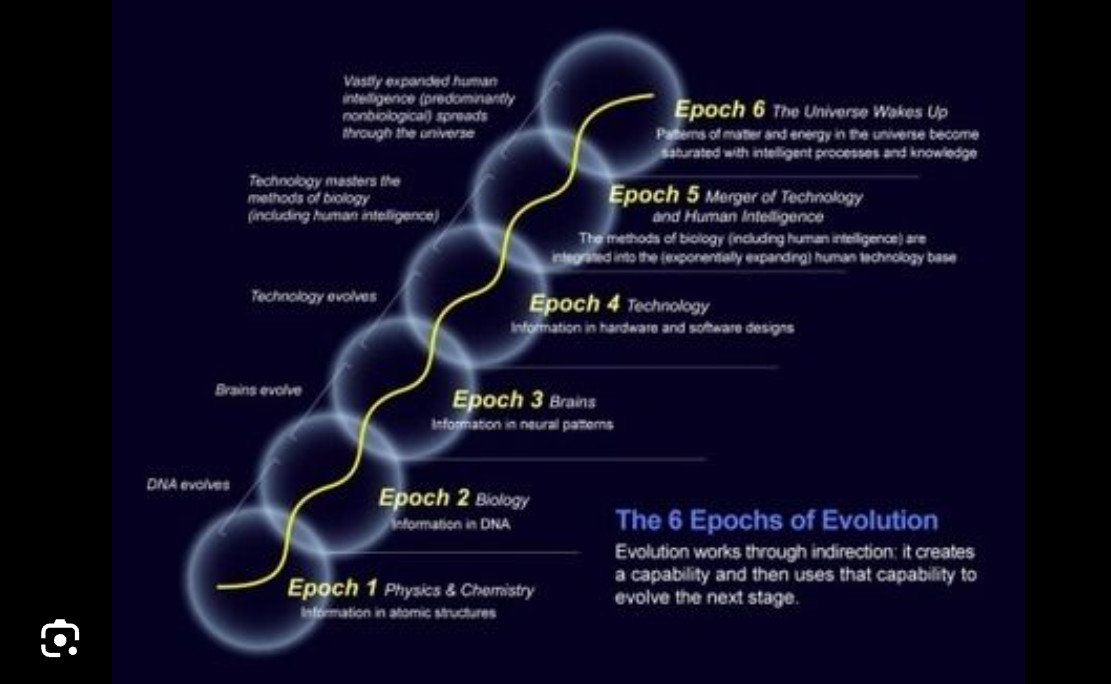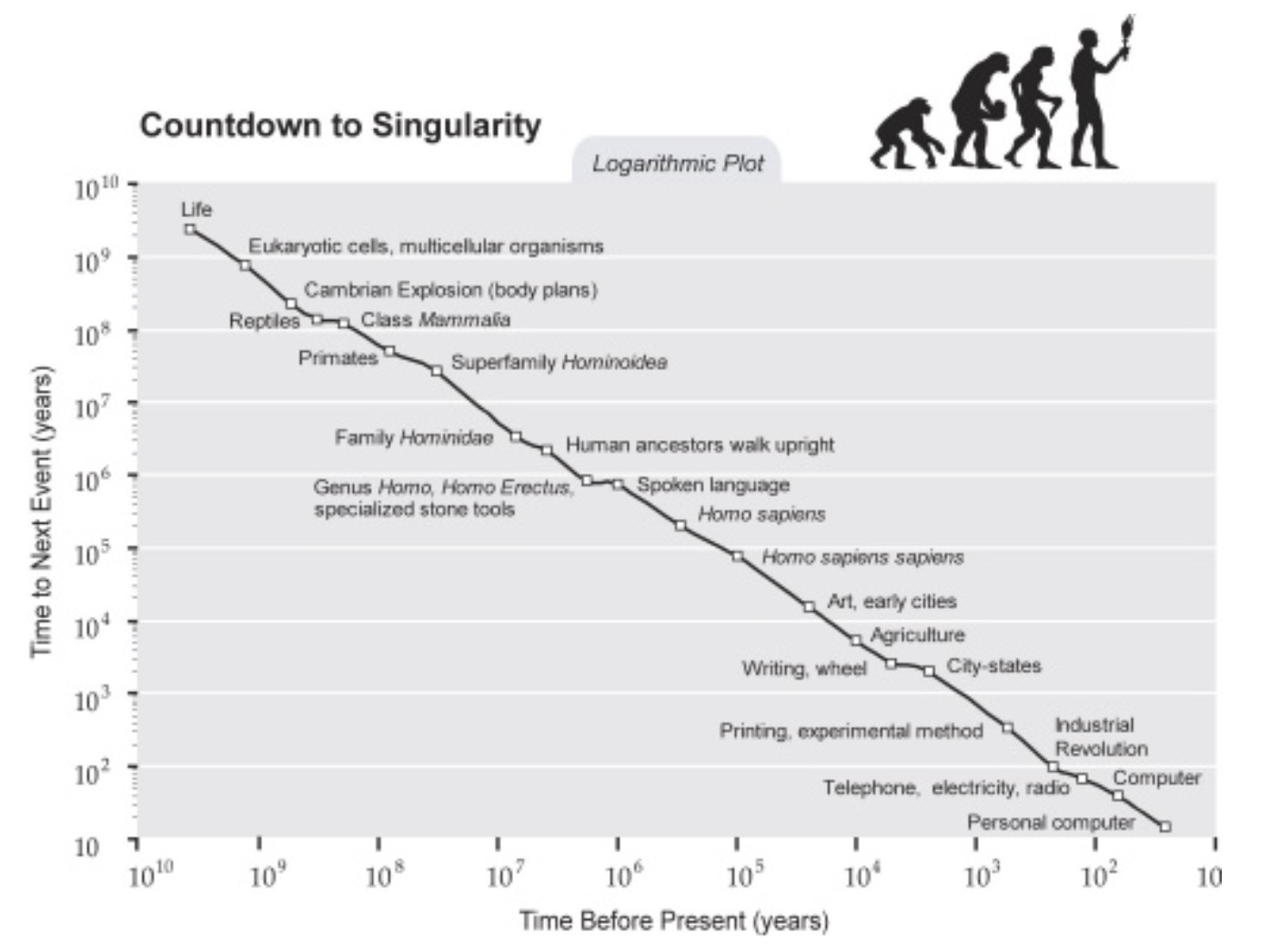Ray Kurzweil’s Six Epochs
[Note: Look here for Part 1: Introducing Ray Kurzweil and Part 2: The Law of Accelerating Returns (Explained) of my series on Ray Kurzweil.]
Evolution is a process of creating patterns of increasing order. Ray Kurzweil
Before I start describing Ray Kurzweil’s predictions, I feel it’s important to first describe Ray’s perspective on life and the universe itself, defined by six distinct time periods he calls “epochs.” You see, these epochs provide the structure and foundation upon which Ray bases his predictions.
You are probably already aware of the fact that Ray Kurzweil is a scientist, a computer scientist. But you may not know just how deep Ray is into the topic of evolution and his strong belief that the two subjects, computer science and evolution, are tied together. So take a guess. What is the tie that binds computer science and evolution? Give up? Would you be surprised if I told you that the tie that binds them is… information? Don’t be. These days the general consensus of the scientific community is that information is the essence of existence and is its most fundamental property. Join me as we explore the history of the universe with Ray Kurzweil!
The universe is full of stories, not atoms. Muriel Rukeyser
It’s a fact. Our human brains are genetically wired to seek and find patterns everywhere we look. This is one reason people are willing to accept conspiracy theories when the alternative is no theory at all as to why something is happening i.e., better something than nothing. Ray tells us that for him, “…it’s the evolution of patterns that constitutes the ultimate story of our world.”[i] And for Ray, the evolution of the entire universe, both biologically and technologically, takes place within six epochs. Please note that with the exception of the first epoch, each subsequent epoch builds upon the epoch previous to it.
While Ray is a scientist, a futurist, an inventor, an engineer and many other things, he’s not the guy I go to for philosophy, physics, biology, etc., so I give him some leeway when he tends to over-simplify and/or generalize on such topics.
Oh, here’s a spoiler alert, without giving too much away: The Singularity occurs in epoch 5 and spreads from the Earth to the rest of the universe in epoch 6. Ray describes epoch 6 as the time when the universe “wakes up.” Wait, what? I know, that threw me, too. read on.

Epoch 1: Physics and Chemistry
This epoch could realistically be described by starting with the familiar refrain, “In the beginning…” because this is where the universe itself begins, described as a state “…that represents information in its basic structures: patterns of matter and energy.” Dig deeper into the lower levels of matter and energy and you soon enter the field of quantum mechanics, where both time and space are further broken down into discrete pieces called, quanta, which can appropriately be described as “…fragments of information.”[ii] These days, one thing scientists can all agree on is that “…atomic structures store and represent discrete information.”
In his book, “The Singularity is Near,” Ray describes this epoch as beginning a few hundred thousand years after the Big Bang. This is when atoms first appeared as electrons became trapped in the orbits around protons and neutrons. According to Ray, this type of electrical structure made the atoms “sticky.”
A few million years later, the atoms came together and began forming “stable structures” called molecules, which led to the birth of chemistry. Of these molecules, carbon proved most versatile! Most molecules form bonds in one to three directions at best, but carbon has the ability to form bonds in four directions! This gave rise to “…complicated, information-rich, three-dimensional structures.”[iii]
Epoch 2: Biology and DNA
In Epoch 2, starting several billion years ago, those busy carbon-based compounds from the first epoch evolved, becoming more and more complex molecules, eventually achieving self-replication and then, suddenly… life happened! These resulting biological systems eventually evolved a precise digital mechanism (DNA) to store information pertaining to an even larger set of molecules. This molecule and its supporting cadre of nucleotides (codons) and ribosomes enabled a record to be kept regarding all of the evolutionary experiments going on during this epoch!
Epoch 3: Brains
In this third epoch, the evolution of information continues, building upon the epoch that preceded it. This is when evolution, guided by DNA, produced organisms that could detect information with sensory organs, and then enabled these organisms to process and store that information with their brains and nervous systems. This was only made possible by what happened in the second epoch.
It is here in the third epoch that animals developed the ability to recognize patterns, an ability that Ray reminds us “…still accounts for the vast majority of the activity in our brains.”[iv]
As you might guess, the third epoch is where we humans first appear. Yay! We made it! Evolution ultimately gave us humans the ability to create and contemplate abstract models of the world we live in and experience, which in turn, gave us “…the ability to redesign the world in our own minds and put these ideas into action.”[v]
Epoch 4: Technology
This 4th epoch is where evolution managed to combine our human “…endowment of rational and abstract thought with our opposable thumb…” and usher in the next layer of evolution: human-created technology! In other words, this is where, uh, I mean when we are right now!
What started out with simple mechanisms eventually became more and more elaborate, eventually developing into very sophisticated computers and communication devices, providing us with technology that was “…capable of sensing, storing, and evaluating elaborate patterns of information.”[vi]
Ray tells us that if we were to compare the rate of progress for our biological intelligence with the evolution of technology, we’d find that while the most advanced mammals have added about one cubic inch of grey matter every 100,000 years, we are roughly doubling the computational capacity of computers every year!
As you can see in the graphic below that Ray created, if you place key milestones of both biological evolution and technology development on a single graph, plotting both the x-axis (number of years ago) and the y-axis (the paradigm shift time) on logarithmic scales, you will see an almost straight line of continual acceleration with biological evolution, “…leading directly to human-directed development.”[vii]

How cool is that?
Ray discusses a couple other charts in his book that I won’t get into here. They essentially do a good job of further hammering home his point that the trend is real and not something he’s making up, which has also been verified by others in the scientific community.
Ray concludes his discussion of epoch 4 with this:
“The attributes that are growing exponentially in these charts are order and complexity… This acceleration matches our commonsense observations. A billion years ago, not much happened over the course of even one million years. But a quarter-million years ago epochal events such as the evolution of our species occurred in time frames of just one hundred thousand years. In technology, if we go back fifty thousand years, not much happened over a one-thousand-year period. But in the recent past, we see new paradigms, such as the World Wide Web, progress from inception to mass adoption (meaning that they are used by a quarter of the population in advanced countries) within only a decade.”
He’s not wrong, I think.
Epoch 5: The Merger of Human Technology with Human Intelligence.
[If you need to refresh your memory of things like AGI, Singularity, etc., read my articles: The Rise of Superintelligence: Our Future with AGI and ASI and Exploring the Capabilities and Types of Artificial Intelligence.]
In 2005, when Ray wrote his book, “The Singularity is Near,” he says that we now have to look ahead several decades, as that is when he predicts the Singularity will make its appearance. Be aware that Ray has since written a second book titled, “The Singularity is Nearer,” due out in 2024. The title betrays the fact that he has moved the anticipated arrival of the Singularity forward quite a bit. He’s not alone. Just recently an open letter from 48 different scientists to the AI community at large was written stating that they believe the time to achieving an AGI (artificial general intelligence) can happen much sooner than people think. They essentially lowered their expectations by several decades, placing the arrival of an AGI within the next 5 years. The AGI is coming, folks!
Ray believes the Singularity will result from merging the information contained in human brains with the “…vastly greater capacity, speed and knowledge-sharing ability of our technology.”[viii] This combination is what is going to “…enable our human-machine civilization to transcend the human brain’s limitations of a mere hundred trillion extremely slow connections.”[ix]
I have to admit that when I look at the future, it does indeed appear that a merger of man-machine is going to happen, and when it does, life as we know it will – again – change dramatically. It’s inevitable, I think. It’s also our ticket off the planet. If we have any hope of exploring our universe, I believe this merger has to happen. The way Ray puts it is such a merger will preserve and enhance human intelligence while allowing us to overcome “the profound limitations” of biological evolution.
Ray cautions that “…the Singularity will also amplify the ability to act on our destructive inclinations, so its full story has not yet been written.”[x] He’s not wrong here, either!
Epoch 6: The Universe Wakes Up
According to Ray, after the Singularity occurs, the very matter and energy surrounding us will become infused with intelligence. It will do this by reorganizing matter and energy to “…provide an optimal level of computation…” that will then “…spread out from its origin on Earth.”[xi]
I don’t know yet if he gets into it in his book, but somewhere between epoch 5 and 6 AI is going to merge with quantum computing. When that happens, think “magic.” For example, Ray mentions the speed of light limitation in his discussion of epoch 6 and ponders whether we may be able to find a way around it. He says that this may well be the factor that determines whether our civilization infuses the rest of the universe with intelligence quickly, or slowly.
Ray concludes that so-called “dumb” matter and mechanisms will be transformed into “sublime forms of intelligence,” which will “…constitute the sixth epoch in the evolution of patterns of information.
This, he says, “…is the ultimate destiny of the Singularity and of the universe.”
I will – finally – get to Ray Kurzweil’s predictions in my next post in this series. I promise!
[i] “The Singularity is Near” by Ray Kurzweil. 2005.
[ii] Ibid.
[iii] Ibid.
[iv] Ibid.
[v] Ibid.
[vi] Ibid.
[vii] Ibid.
[viii] Ibid.
[ix] Ibid.
[x] Ibid.
[xi] Ibid.